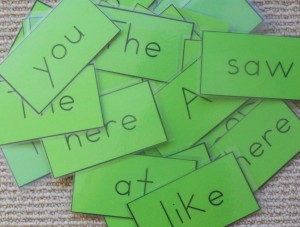 For both first and second graders, a valuable part of our reading time each day is spent on practicing sight words. Readers need to know these words automatically when reading. To begin the process, students are given a set of 20-25 words. Students sort the words into Friend words, words that are well known, and Acquaintance words, words that are unfamiliar. These words are stored in a 2 sided pocket and students practice the Friend words first. I conference with each student, listening as they read their words. Next, I teach them 1-3 new words from their Acquaintance side. In this way, new learning happens in manageable pieces, and is reinforced with repeated practice. When the word set is mastered, students get a stamp on their hand (they love this!) and they start working on new words.
For both first and second graders, a valuable part of our reading time each day is spent on practicing sight words. Readers need to know these words automatically when reading. To begin the process, students are given a set of 20-25 words. Students sort the words into Friend words, words that are well known, and Acquaintance words, words that are unfamiliar. These words are stored in a 2 sided pocket and students practice the Friend words first. I conference with each student, listening as they read their words. Next, I teach them 1-3 new words from their Acquaintance side. In this way, new learning happens in manageable pieces, and is reinforced with repeated practice. When the word set is mastered, students get a stamp on their hand (they love this!) and they start working on new words.
These words come from two sources, the Dolch list and the MLPP list, which contain words for children in kindergarten through third grade. Learning these words help beginning readers in several ways. When students master the words, they have tangible evidence that they are making progress in learning to read. Also, when readers quickly recognize these words while reading, they can spend more time on understanding the story. Learning these words help to establish patterns, so that similar words can often be recognized as well. Each month, I reassess children’s sight word progress and we examine their growth together. This will be one of the many assessments that I look forward to sharing with you at parent/teacher conferences. If you are interested in working on these words at home, email me and I will send home an additional set with your child.
